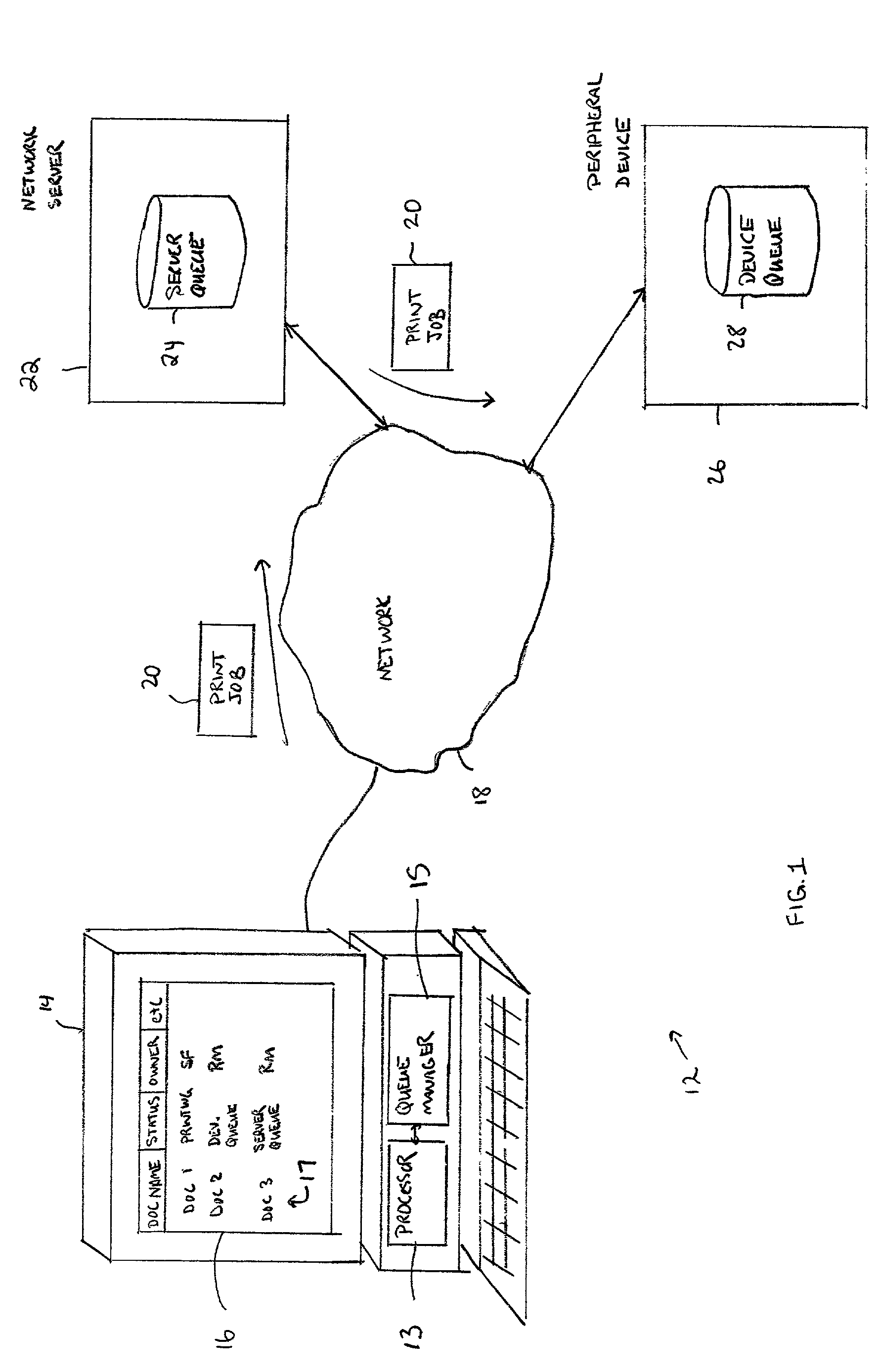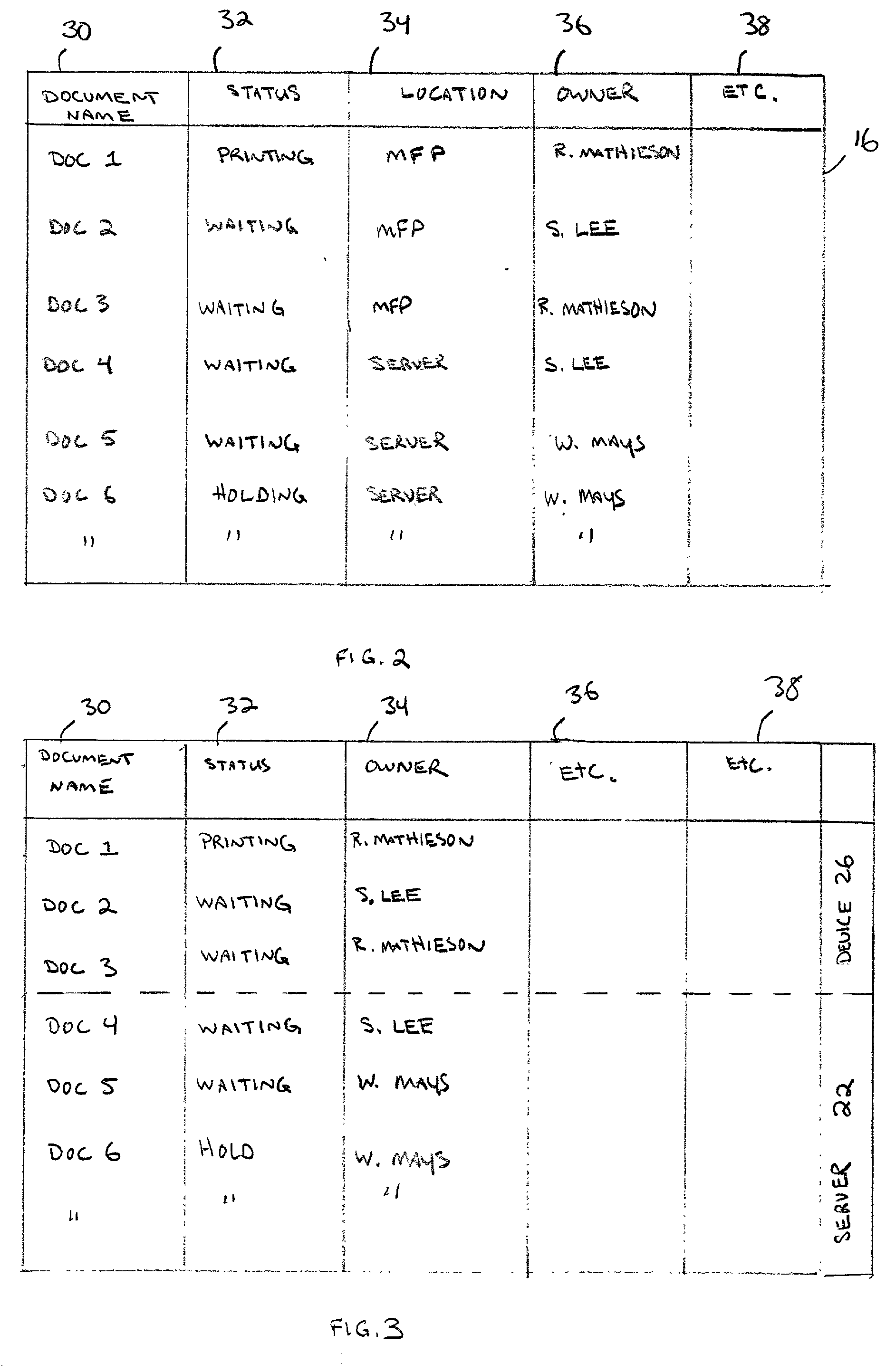Method and apparatus for managing job queues
a technology for managing job queues and queues, applied in the direction of program control, digital output to print units, multi-programming arrangements, etc., can solve the problems of not being able to effectively manage multiple job queues, user or administrator cannot effectively manipulate the scheduling of jobs from multiple job queues, and none of these user interfaces can manage more than one job queu
- Summary
- Abstract
- Description
- Claims
- Application Information
AI Technical Summary
Benefits of technology
Problems solved by technology
Method used
Image
Examples
case 66
[0023]Case 66 shows the cancel or pause operation for a job that currently resides in the server queue 24. The queue manager 15 identifies a job on the user interface that has been selected by the user for cancellation or pausing. The queue manager 15 identifies the server queue 24 as storing the selected queue and accordingly sends a cancel request 63 to the server queue 24. The network server deletes or pauses the selected job in server queue 24 according to the request 63 and sends out a confirmation 65 back to the queue manager 15. The queue manager 15 then updates the job list on the user interface to reflect the cancelled or paused job.
[0024]When a user is selecting jobs from the user interface display, some of the jobs may have already moved from the server queue 24 to the device queue 28. The queue manager automatically adjusts how the cancel or pause requests are sent according to where the job is currently located on the server queue 24 or device queue 28. Case 68 deals wi...
case 78
[0027]Case 78 shows an alternative way to implement the condition where a job 81 moves from the server queue to the device queue 28 after the job 81 is selected. Instead of first sending a cancel request to the server queue 24, the queue manager 15 sends a cancel or pause request 80 to both the server queue 24 and the device queue 28 at the same time. This eliminates the queue manager 15 from having to identify which queue currently stores the job 81. As long as a cancel or pause confirmation 82 is received back from one of the queues 24 or 28, the queue manager 15 knows the cancel or pause request has been successfully completed.
[0028]FIG. 6 shows how the queue manager changes the priority of jobs. For example, a user may want to have one job in either the server queue or device queue be the next in line for printing from a peripheral device. If the job is currently fifth on the list of jobs to be output, the user can go to the user interface 16 (FIG. 1) and move the job up to the ...
case 122 deals
[0038]Case 122 deals with demoting a job across the queue boundaries. The user selects a job to be demoted in the device queue 28. The queue manager sends a request 124 to the device queue 28 to hold the selected job until all of the jobs with higher priority have been output. The device queue 28 sends back a confirmation 126. The demoted job may be shown moved on the user interface 16 but may not be physically moved in the device queue 28. For example, the device queue 28 may hold the selected job until the higher priority jobs have been output. Then the selected job is released for outputting.
[0039]The commands sent between the queue manager and the queues in one embodiment are sent using proprietary or standardized network protocols such as Simple Network Management Protocol (SNMP) / Job Management Information Base (MIB) or Internet Printing Protocol (IPP). Extensions to these network protocols may be added to provide some of the functions described above. Alternatively, a custom n...
PUM
 Login to View More
Login to View More Abstract
Description
Claims
Application Information
 Login to View More
Login to View More - R&D
- Intellectual Property
- Life Sciences
- Materials
- Tech Scout
- Unparalleled Data Quality
- Higher Quality Content
- 60% Fewer Hallucinations
Browse by: Latest US Patents, China's latest patents, Technical Efficacy Thesaurus, Application Domain, Technology Topic, Popular Technical Reports.
© 2025 PatSnap. All rights reserved.Legal|Privacy policy|Modern Slavery Act Transparency Statement|Sitemap|About US| Contact US: help@patsnap.com



